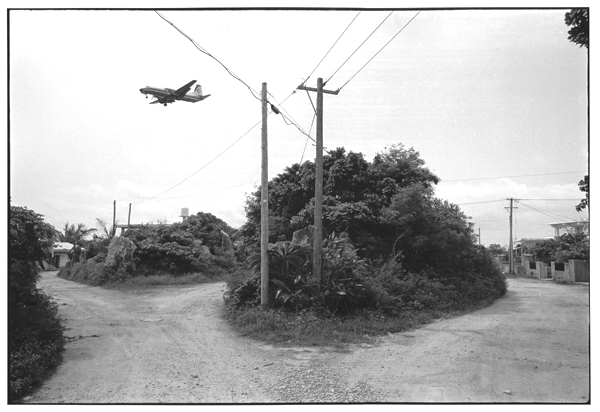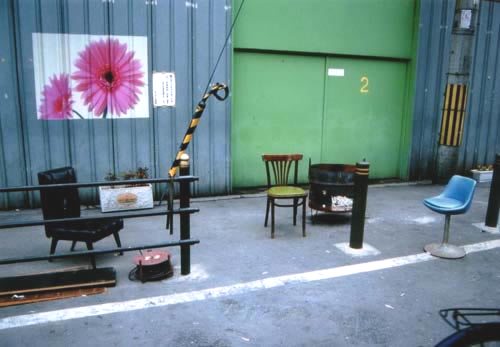 Yaniv Waissa is a young Israeli photographer working around memory and landscape. His series Disintegration of a Revived Nation deals with "the urban revolution, manifested in the massive construction of buildings, roads, bridges and all kinds of huge concrete structures," and "with the changing generations." His statement on the series contains no overt political messages and mentions nothing about the Arab-Israeli conflict, but I find that this work, which deals with rebuilding and replacing the old with the new in Israel, gains a layer of meaning by virtue of the political context in which it is being made.
Yaniv Waissa is a young Israeli photographer working around memory and landscape. His series Disintegration of a Revived Nation deals with "the urban revolution, manifested in the massive construction of buildings, roads, bridges and all kinds of huge concrete structures," and "with the changing generations." His statement on the series contains no overt political messages and mentions nothing about the Arab-Israeli conflict, but I find that this work, which deals with rebuilding and replacing the old with the new in Israel, gains a layer of meaning by virtue of the political context in which it is being made.
Yamashita Tsuneo
 Yamashita Tsuneo's website has some great work that shows just how far you can go with simplicity.
Yamashita Tsuneo's website has some great work that shows just how far you can go with simplicity.
(via mcvmcv)
No such thing as a free house?
 With his Zero Yen House series Kyohei Sakaguchi has been studying the 'vernacular architecture' of self-built homeless shelters in Japan's three largest cities (Tokyo, Osaka and Nagoya) for almost 10 years. He uses photographs, descriptions, architectural drawings and video to explore these structures from the perspective of architecture and sustainable development.
With his Zero Yen House series Kyohei Sakaguchi has been studying the 'vernacular architecture' of self-built homeless shelters in Japan's three largest cities (Tokyo, Osaka and Nagoya) for almost 10 years. He uses photographs, descriptions, architectural drawings and video to explore these structures from the perspective of architecture and sustainable development.
Sakaguchi has made some fascinating finds: a two-storey house with a karaoke system in the basement, a house that is entered through a reappropriated playground slide, a cardboard home on wheels, or a dismantlable solar house made entirely from waste products. In addition to these shelters he also studies how they make use of open urban spaces (see the image above) or how Tokyoites can grow gardens pretty much anywhere. Sakaguchi doesn't seem to be interested in commenting on the problem of homelessness, but rather in showing how these self-made architects' ingenuity can provide us with lessons for the future of urban living. The fact that they are homeless ends up feeling almost entirely incidental.
Naoshima: Paradise on Earth?
For this post, I am allowing myself to stray from our beloved photographic shores, but I assure you that it will be worth it. Last Friday I attended a conference at the Palais de Tokyo given for the opening of the exhibition on the Benesse Art Site Naoshima project. This was a pretty star-studded affair: super-architects Ryue Nishizawa and Kazuyo Sejima of SANAA, Hiroshi Sambuichi, Patrick Bouchain (I was half-expecting Tadao Ando to appear from a hole in the stage), with a guest appearance by Christian Boltanski.
Benesse Art Site Naoshima is a fantastically crazy project that was begun by Tetsuhiko Fukutake, the CEO of a publishing company, in 1989 as part of a promise to develop the island of Naoshima. The project is now run by his son, Soichiro Fukutake, who shares his father's eccentric vision of how to conduct business. Benesse (derived from the latin to live better) is Fukutake's modest attempt to "create a new independent country inside of Japan" which could be considered to be "heaven on Earth". This is a man who clearly spends very little time thinking inside of boxes.
The project began with a series of architectural commissions by Tadao Ando on the island of Naoshima, including Benesse House and the Chichu Art Museum, and has now been extended to the neighbouring islands of Teshima, Megijima, Inujima, Ogijima and Shodoshima, and to other architects. Fukutake might sound like a megalomaniac who can't get enough expensive toys to play with, but seeing these projects outlined it is clear that Benesse is much more than that. At the center of the project is a desire to rethink the relationship between art and architecture and to experiment with new possibilities in this field. Fukutake also believes that "culture is superior to the economy" and that the latter should therefore serve the former (6% of his business's capital goes to the Benesse Foundation). There is a genuine attempt to involve the inhabitants in the developments of these projects and to give them the right to veto anything they don't like. The project is helping to redevelop the area, to give the aging population of the region more and better opportunities to earn a living and is even succeeding in attracting the younger generation from Tokyo to settle there. Christian Boltanski, who is preparing a museum of heartbeats as his contribution to the project, described Benesse as a utopic project, "in the important and rare sense of the term."
The only dampener on what was truly an inspirational few hours, was that the exhibition includes a number of Naoya Hatakeyama's fantastic prints, notably of the Chichu Art Museum, and nobody bothered to tell us (or him!) about it.
I would recommend going to the exhibition (although I have never really been blown away by architectural scale models), but, if you can, skip that step and just book your tickets to Naoshima right away. Next summer the first edition of the Setouchi Art Festival will be held on Naoshima and the neighbouring islands... sounds like a pretty good opportunity to me.
Akira Rachi and Hirofumi Katayama
It seems to be Taro Nasu Gallery week on eyecurious this week. Following on from the seemingly excellent Ryuji Miyamoto show, they are now going to be showing work by Akira Rachi and Hirofumi Katayama. This show could be called 'In Between' as both of these two young photographers focus on interstitial spaces. Katayama seeks to find geometric perfection in the city's places of transit that are mostly overlooked: lobbies, entrances, stairways. Rachi's photographs deal with a different kind of space: the space between objects, as if he is trying to capture the physical forces of attraction and repulsion at play.




